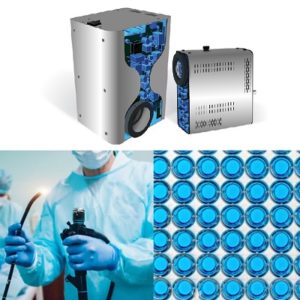
Since CoolLED first emerged as a spin-off from an industrial and academic partnership at the University of Southampton, our target has predominantly been delivering high-performance illumination for microscopy.
Our expertise is essentially broader than this and lies in the generation and delivery of LED light – but not just any LED light! Our technology has instead had to meet the exacting demands of life science microscopy in terms of:
Irradiance – The power of LEDs must be high enough to ensure irradiance at the sample plane that is sufficient to excite fluorescent labels in the sample and result in an emission signal that can be reliably detected against background noise.
Spectral cover – A vast library of fluorescent labels is available to scientists, requiring discrete illumination ranging from 340 nm to 740 nm (and even beyond these regions), and different LEDs must match the many peaks within this range.
Control – The ability to carefully optimise illumination is crucial when working with biological material (especially living cells) – the most important parameters being 0-100% irradiance control and the ability to switch between LED channels at speeds of under 7 µs.
Homogeneity – Many fluorescence microscopy experiments are quantitative, and it is vital that all areas of the sample receive the same illumination in order to ensure accurate scientific data.
Creating such high-performance LED illumination technology has presented a significant challenge to our microscopy illumination experts, and naturally our Amora Series for custom microscopy illumination has focused on life science microscopy. However, as we are beginning to attend exhibitions and enjoy face-to-face discussions once more, we are connecting with an increasing number of diverse organisations interested in our technology to solve their challenges.
Some of the most exciting applications involve surgery and medical endoscopy, or high-throughput analysis of samples in multi-well plates. Industrial applications such as analysing quality of paintwork might also benefit. These are just a couple of examples, but this really has opened our eyes, and we can’t wait to see how the advantages of the Amora Series are helping to move our technology beyond fluorescence microscopy.
Could your application benefit from powerful, controllable and homogenous illumination? Contact us!





